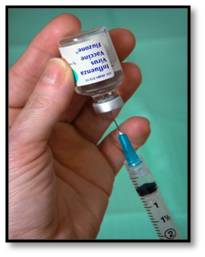Section 1. Avian Influenza Facts
- Source and Transmission
- Agent Characteristics
- Virus Survival
- Clinical Signs in Birds
- HPAI H5N1
- Human Concerns
Avian Influenza Biosecurity for Backyard Flock Owners
Protecting Yourself
Keep in mind that human AI infections are very rare and using everyday biosecurity precautions are the first step to prevention.
- Use gloves when handling sick or dead birds (for greater protection wear goggles and face masks).
- Avoid contact with droppings and do not touch your mouth or eyes with your hands while working.
- After handling sick or dead birds, change and launder your clothes and always wash your hands with soap and water or gel sanitizer when done.7
In 2007, the Food and Drug Administration (FDA) approved an avian influenza vaccine against one strain of HPAI H5N1 for humans; however, it is not currently available to the public. In the event of a pandemic, the government will distribute the vaccine as needed. |
 CDC Photo Library: Jim Gathany |
